Valorization of Rice Straw via Hydrotropic Lignin Extraction and Its Characterization
Abstract
:1. Introduction
2. Results and Discussion
2.1. p-TsOH Fractionated Rice Straw Lignin
2.2. AFM Analysis
2.3. Particle Size Distribution of Lignin
2.4. Gel Permeation Chromatographic (GPC) Analyses
2.5. Chemical Structure and Functional Groups of the Hydrotropic Lignins
2.6. Thermal Characteristics of Lignin
3. Materials and Methods
3.1. Chemicals
3.2. p-TsOH Fractionation and Alkali Fractionation of Rice Straw
3.3. Atomic Force Microscopy (AFM) Analysis
3.4. Particle Size Measurement
3.5. Gel Permeation Chromatographic (GPC) Analysis
3.6. Fourier Transform-Infrared (FT-IR) Spectroscopy Analysis
3.7. Nuclear Magnetic Resonance (NMR) Spectroscopic Analyses of Lignin
3.8. Thermogravimetric (TG) Analysis
3.9. Differential Scanning Calorimetric (DSC) Analyses
4. Conclusions
Author Contributions
Funding
Institutional Review Board Statement
Informed Consent Statement
Data Availability Statement
Acknowledgments
Conflicts of Interest
Sample Availability
References
- Gupta, G.K.; Shukla, P. Insights into the resources generation from pulp and paper industry wastes: Challenges, perspectives and innovations. Bioresour. Technol. 2020, 297, 122496. [Google Scholar] [CrossRef]
- Morris, J. Recycle, Bury, or Burn Wood Waste Biomass? LCA Answer Depends on Carbon Accounting, Emissions Controls, Displaced Fuels, and Impact Costs. J. Ind. Ecol. 2017, 21, 844–856. [Google Scholar] [CrossRef]
- Wu, J.; Dong, L.; Liu, B.; Xing, D.; Zhou, C.; Wang, Q.; Wu, X.; Feng, L.; Cao, G. A novel integrated process to convert cellulose and hemicellulose in rice straw to biobutanol. Environ. Res. 2020, 186, 109580. [Google Scholar] [CrossRef]
- Schutyser, W.; Renders, T.; Van den Bosch, S.; Koelewijn, S.F.; Beckham, G.T.; Sels, B.F. Chemicals from lignin: An interplay of lignocellulose fractionation, depolymerisation, and upgrading. Chem. Soc. Rev. 2018, 47, 852–908. [Google Scholar] [CrossRef]
- Dusselier, M.; Mascal, M.; Sels, B.F. Top Chemical Opportunities from Carbohydrate Biomass: A Chemist’s View of the Biorefinery. In Selective Catalysis for Renewable Feedstocks and Chemicals; Nicholas, K.M., Ed.; Springer International: Cham, Switzerland, 2014; Volume 353, pp. 1–40. [Google Scholar]
- Behling, R.; Valange, S.; Chatel, G. Heterogeneous catalytic oxidation for lignin valorization into valuable chemicals: What results? What limitations? What trends? Green Chem. 2016, 18, 1839–1854. [Google Scholar] [CrossRef]
- Pan, X.; Gilkes, N.; Kadla, J.; Pye, K.; Saka, S.; Gregg, D.; Ehara, K.; Xie, D.; Lam, D.; Saddler, J. Bioconversion of hybrid poplar to ethanol and co-products using an organosolv fractionation process: Optimization of process yields. Biotechnol. Bioeng. 2006, 94, 851–861. [Google Scholar] [CrossRef]
- Singh, G.; Arya, S.K. A review on management of rice straw by use of cleaner technologies: Abundant opportunities and expectations for Indian farming. J. Clean. Prod. 2020, 291, 125278. [Google Scholar] [CrossRef]
- Cheng, J.; Leu, S.-Y.; Zhu, J.Y.; Jeffries, T.W. Ethanol production from non-detoxified whole slurry of sulfite-pretreated empty fruit bunches at a low cellulase loading. Bioresour. Technol. 2014, 164, 331–337. [Google Scholar] [CrossRef] [PubMed]
- Lim, W.-L.; Gunny, A.A.N.; Kasim, F.H.; AiNashef, I.M.; Arbain, D. Alkaline deep eutectic solvent: A novel green solvent for lignocellulose pulping. Cellulose 2019, 26, 4085–4098. [Google Scholar] [CrossRef]
- Jahan, M.S.; Sutradhar, S.; Rahman, M.M.; Quaiyyum, M.A. Fractionation of rice straw for producing dissolving pulp in biorefinery concept. Nord. Pulp Pap. Res. J. 2015, 30, 562–567. [Google Scholar]
- Nowakowski, D.J.; Jones, J.M. Uncatalysed and potassium-catalysed pyrolysis of the cell-wall constituents of biomass and their model compounds. J. Anal. Appl. Pyrolysis 2008, 83, 12–25. [Google Scholar] [CrossRef]
- Moiseenko, K.V.; Glazunova, O.A.; Savinova, O.S.; Vasina, D.V.; Zherebker, A.Y.; Kulikova, N.A.; Nikolaev, E.N.; Fedorova, T.V. Relation between lignin molecular profile and fungal exo-proteome during kraft lignin modification by Trametes hirsuta LE-BIN 072. Bioresour. Technol. 2021, 335, 125229. [Google Scholar] [CrossRef]
- Lahtinen, M.H.; Mikkila, J.; Mikkonen, K.S.; Kilpelainen, I. Kraft Process-Formation of Secoisolariciresinol Structures and Incorporation of Fatty Acids in Kraft Lignin. J. Agric. Food Chem. 2021, 69, 5955–5965. [Google Scholar] [CrossRef]
- Hodgdon, T.K.; Kaler, E.W. Hydrotropic solutions. Curr. Opin. Colloid Interface Sci. 2007, 12, 121–128. [Google Scholar]
- Chen, H.; Jiang, B.; Wu, W.; Jin, Y. Comparison of enzymatic saccharification and lignin structure of masson pine and poplar pretreated by p-Toluenesulfonic acid. Int. J. Biol. Macromol. 2020, 151, 861–869. [Google Scholar] [CrossRef] [PubMed]
- Wang, W.; Gu, F.; Zhu, J.Y.; Sun, K.; Cai, Z.; Yao, S.; Wu, W.; Jin, Y. Fractionation of herbaceous biomass using a recyclable hydrotropic p-toluenesulfonic acid (p-TsOH)/choline chloride (ChCl) solvent system at low temperatures. Ind. Crops Prod. 2020, 150, 112423. [Google Scholar] [CrossRef]
- Chen, L.; Dou, J.; Ma, Q.; Li, N.; Wu, R.; Bian, H.; Yelle, D.J.; Vuorinen, T.; Fu, S.; Pan, X.; et al. Rapid and near-complete dissolution of wood lignin at ≤ 80 degrees C by a recyclable acid hydrotrope. Sci. Adv. 2017, 3, e1701735. [Google Scholar] [CrossRef] [Green Version]
- Kunz, W.; Holmberg, K.; Zemb, T. Hydrotropes. Curr. Opin. Colloid Interface Sci. 2016, 22, 99–107. [Google Scholar]
- Ma, Q.; Chen, L.; Wang, R.; Yang, R.; Zhu, J.Y. Direct production of lignin nanoparticles (LNPs) from wood using p-toluenesulfonic acid in an aqueous system at 80 degrees C: Characterization of LNP morphology, size, and surface charge. Holzforschung 2018, 72, 933–942. [Google Scholar] [CrossRef]
- Cheng, J.; Hirth, K.; Ma, Q.; Zhu, J.; Wang, Z.; Zhu, J.Y. Toward Sustainable and Complete Wood Valorization by Fractionating Lignin with Low Condensation Using an Acid Hydrotrope at Low Temperatures (≤ 80 degrees C). Ind. Eng. Chem. Res. 2019, 58, 7063–7073. [Google Scholar] [CrossRef]
- Wang, Z.; Qiu, S.; Hirth, K.; Cheng, J.; Wen, J.; Li, N.; Fang, Y.; Pan, X.; Zhu, J.Y. Preserving Both Lignin and Cellulose Chemical Structures: Flow-Through Acid Hydrotropic Fractionation at Atmospheric Pressure for Complete Wood Valorization. Acs Sustain. Chem. Eng. 2019, 7, 10808–10820. [Google Scholar] [CrossRef]
- Chen, L.; Zhu, J.Y.; Baez, C.; Kitin, P.; Elder, T. Highly thermal-stable and functional cellulose nanocrystals and nanofibrils produced using fully recyclable organic acids. Green Chem. 2016, 18, 3835–3843. [Google Scholar] [CrossRef]
- Ma, Q.; Zhu, J.; Gleisner, R.; Yang, R.; Zhu, J.Y. Valorization of Wheat Straw Using a Recyclable Hydrotrope at Low Temperatures (≤ 90 degrees C). Acs Sustain. Chem. Eng. 2018, 6, 14480–14489. [Google Scholar] [CrossRef]
- Leu, S.Y.; Zhu, J.Y.; Gleisner, R.; Sessions, J.; Marrs, G. Robust enzymatic saccharification of a Douglas-fir forest harvest residue by SPORL. Biomass Bioenergy 2013, 59, 393–401. [Google Scholar]
- Su, C.; Hirth, K.; Liu, Z.; Cao, Y.; Zhu, J.Y. Acid hydrotropic fractionation of switchgrass at atmospheric pressure using maleic acid in comparison with p-TsOH: Advantages of lignin esterification. Ind. Crops Prod. 2021, 159, 113017. [Google Scholar] [CrossRef]
- Bian, H.; Dong, M.; Chen, L.; Zhou, X.; Wang, R.; Jiao, L.; Ji, X.; Dai, H. On-Demand Regulation of Lignocellulosic Nanofibrils Based on Rapid Fractionation Using Acid Hydrotrope: Kinetic Study and Characterization. ACS Sustain. Chem. Eng. 2020, 8, 9569–9577. [Google Scholar] [CrossRef]
- Deng, J.; Sun, S.-F.; Zhu, E.-Q.; Yang, J.; Yang, H.-Y.; Wang, D.-W.; Ma, M.-G.; Shi, Z.-J. Sub-micro and nano-lignin materials: Small size and rapid progress. Ind. Crops Prod. 2021, 164, 113412. [Google Scholar] [CrossRef]
- Moradi, S.; Shayesteh, K.; Behbudi, G. Preparation and characterization of biodegradable lignin-sulfonate nanoparticles using the microemulsion method to enhance the acetylation efficiency of lignin-sulfonate. Int. J. Biol. Macromol. 2020, 160, 632–641. [Google Scholar] [CrossRef]
- Freitas, F.M.C.; Cerqueira, M.A.; Gonçalves, C.; Azinheiro, S.; Garrido-Maestu, A.; Vicente, A.A.; Pastrana, L.M.; Teixeira, J.A.; Michelin, M. Green synthesis of lignin nano- and micro-particles: Physicochemical characterization, bioactive properties and cytotoxicity assessment. Int. J. Biol. Macromol. 2020, 163, 1798–1809. [Google Scholar] [CrossRef]
- Mou, H.Y.; Heikkilä, E.; Fardim, P. Topochemistry of alkaline, alkaline-peroxide and hydrotropic pretreatments of common reed to enhance enzymatic hydrolysis efficiency. Bioresour. Technol. 2013, 150, 36–41. [Google Scholar] [CrossRef] [PubMed]
- Pereira Araujo, L.C.; Yamaji, F.M.; Lima, V.H.; Botaro, V.R. Kraft lignin fractionation by organic solvents: Correlation between molar mass and higher heating value. Bioresour. Technol. 2020, 314, 123757. [Google Scholar] [CrossRef] [PubMed]
- Wen, J.-L.; Sun, S.-N.; Yuan, T.-Q.; Xu, F.; Sun, R.-C. Fractionation of bamboo culms by autohydrolysis, organosolv delignification and extended delignification: Understanding the fundamental chemistry of the lignin during the integrated process. Bioresour. Technol. 2013, 150, 278–286. [Google Scholar] [CrossRef] [PubMed]
- Del Rio, J.C.; Rencoret, J.; Prinsen, P.; Martinez, A.T.; Ralph, J.; Gutierrez, A. Structural Characterization of Wheat Straw Lignin as Revealed by Analytical Pyrolysis, 2D-NMR, and Reductive Cleavage Methods. J. Agric. Food Chem. 2012, 60, 5922–5935. [Google Scholar] [CrossRef] [PubMed] [Green Version]
- Yelle, D.J.; Ralph, J.; Frihart, C.R. Characterization of nonderivatized plant cell walls using high-resolution solution-state NMR spectroscopy. Magn. Reson. Chem. 2008, 46, 508–517. [Google Scholar] [CrossRef]
- Liu, C.; Wang, X.; Lin, F.; Zhang, H.; Xiao, R. Structural elucidation of industrial bioethanol residual lignin from corn stalk: A potential source of vinyl phenolics. Fuel Process. Technol. 2018, 169, 50–57. [Google Scholar] [CrossRef]
- Zeng, J.; Helms, G.L.; Gao, X.; Chen, S. Quantification of Wheat Straw Lignin Structure by Comprehensive NMR Analysis. J. Agric. Food Chem. 2013, 61, 10848–10857. [Google Scholar] [CrossRef]
- Li, N.; Li, Y.; Yoo, C.G.; Yang, X.; Lin, X.; Ralph, J.; Pan, X. An uncondensed lignin depolymerized in the solid state and isolated from lignocellulosic biomass: A mechanistic study. Green Chem. 2018, 20, 4224–4235. [Google Scholar] [CrossRef] [Green Version]
- Yuan, T.Q.; Sun, S.N.; Xu, F.; Sun, R.C. Characterization of Lignin Structures and Lignin-Carbohydrate Complex (LCC) Linkages by Quantitative C-13 and 2D HSQC NMR Spectroscopy. J. Agric. Food Chem. 2011, 59, 10604–10614. [Google Scholar] [CrossRef]
- Jiang, B.; Zhang, Y.; Gu, L.; Wu, W.; Zhao, H.; Jin, Y. Structural elucidation and antioxidant activity of lignin isolated from rice straw and alkalioxygen black liquor. Int. J. Biol. Macromol. 2018, 116, 513–519. [Google Scholar] [CrossRef]
- Shuai, L.; Amiri, M.T.; Questell-Santiago, Y.M.; Heroguel, F.; Li, Y.; Kim, H.; Meilan, R.; Chapple, C.; Ralph, J.; Luterbacher, J.S. Formaldehyde stabilization facilitates lignin monomer production during biomass depolymerization. Science 2016, 354, 329–333. [Google Scholar] [CrossRef] [Green Version]
- Yang, H.; Xie, Y.; Zheng, X.; Pu, Y.; Huang, F.; Meng, X.; Wu, W.; Ragauskas, A.; Yao, L. Comparative study of lignin characteristics from wheat straw obtained by soda-AQ and kraft pretreatment and effect on the following enzymatic hydrolysis process. Bioresour. Technol. 2016, 207, 361–369. [Google Scholar] [CrossRef]
- Del Rio, J.C.; Gutierrez, A.; Hernando, M.; Landin, P.; Romero, J.; Martinez, A.T. Determining the influence of eucalypt lignin composition in paper pulp yield using Py-GC/MS. J. Anal. Appl. Pyrolysis 2005, 74, 110–115. [Google Scholar] [CrossRef] [Green Version]
- Gutierrez, A.; Rodriguez, I.M.; del Rio, J.C. Chemical characterization of lignin and lipid fractions in industrial hemp bast fibers used for manufacturing high-quality paper pulps. J. Agric. Food Chem. 2006, 54, 2138–2144. [Google Scholar] [CrossRef] [Green Version]
- Min, D.; Yang, C.; Shi, R.; Jameel, H.; Chiang, V.; Chang, H. The elucidation of the lignin structure effect on the cellulase-mediated saccharification by genetic engineering poplars (Populus nigra L. x Populus maximowiczii A.). Biomass Bioenergy 2013, 58, 52–57. [Google Scholar] [CrossRef]
- Su, Y.; Huang, C.; Lai, C.; Yong, Q. Green solvent pretreatment for enhanced production of sugars and antioxidative lignin from poplar. Bioresour. Technol. 2021, 321, 124471. [Google Scholar] [CrossRef] [PubMed]
- Santos, V.O.; Queiroz, L.S.; Araujo, R.O.; Ribeiro, F.C.P.; Guimarães, M.N.; da Costa, C.E.F.; Chaar, J.S.; de Souza, L.K.C. Pyrolysis of acai seed biomass: Kinetics and thermodynamic parameters using thermogravimetric analysis. Bioresour. Technol. Rep. 2020, 12, 100553. [Google Scholar] [CrossRef]
- Ninduangdee, P.; Kuprianov, V.I.; Cha, E.Y.; Kaewrath, R.; Youngyuen, P.; Atthawethworawuth, W. Thermogravimetric Studies of Oil Palm Empty Fruit Bunch and Palm Kernel Shell: TG/DTG Analysis and Modeling. Energy Procedia 2015, 79, 453–458. [Google Scholar] [CrossRef] [Green Version]

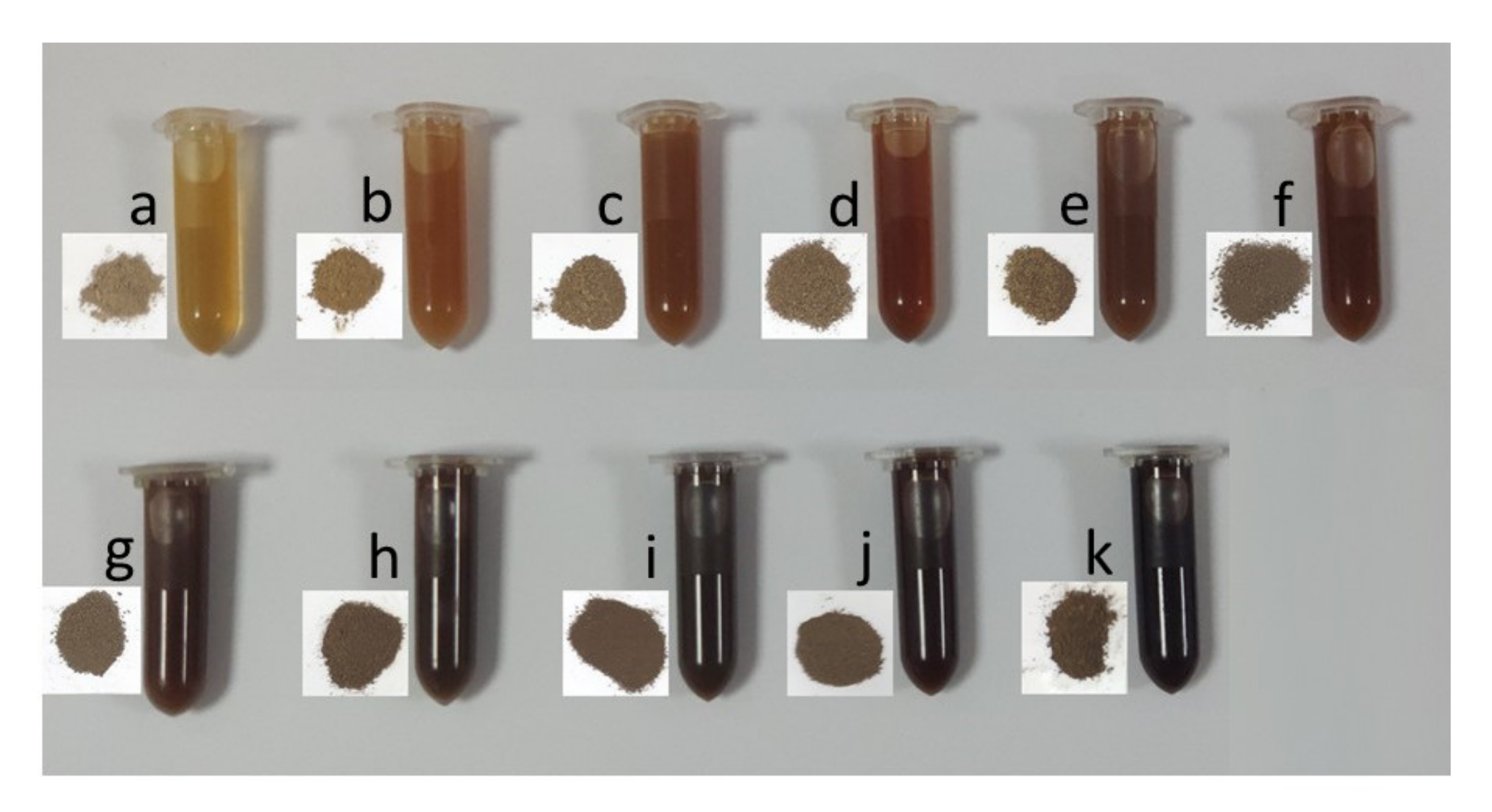

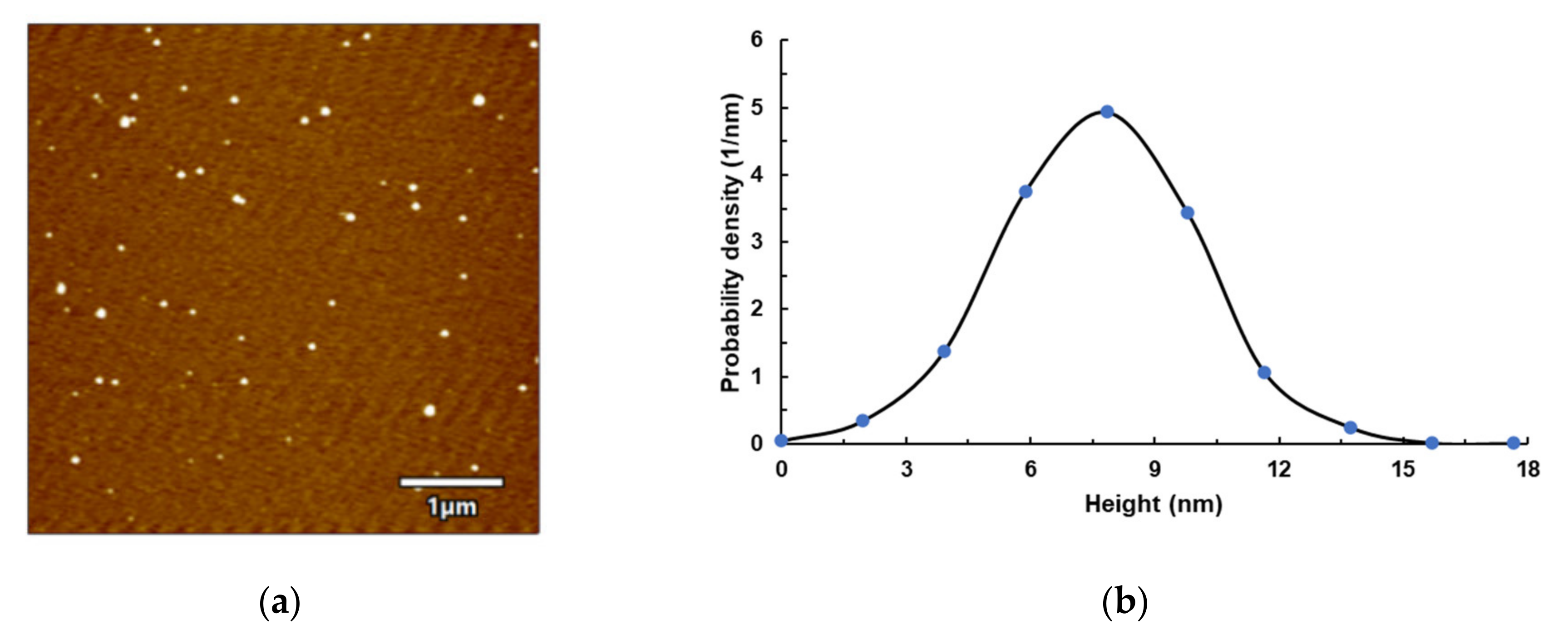

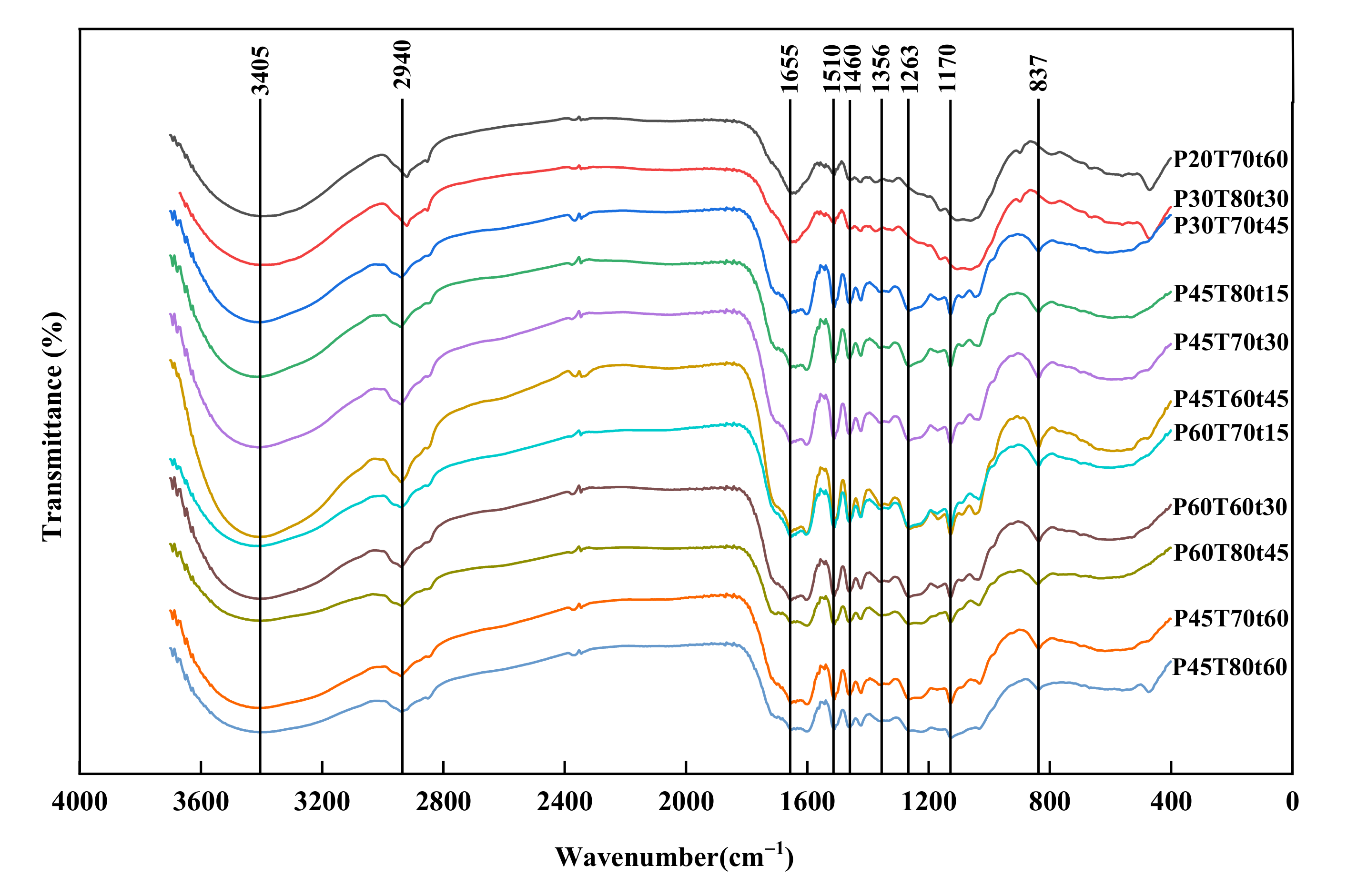
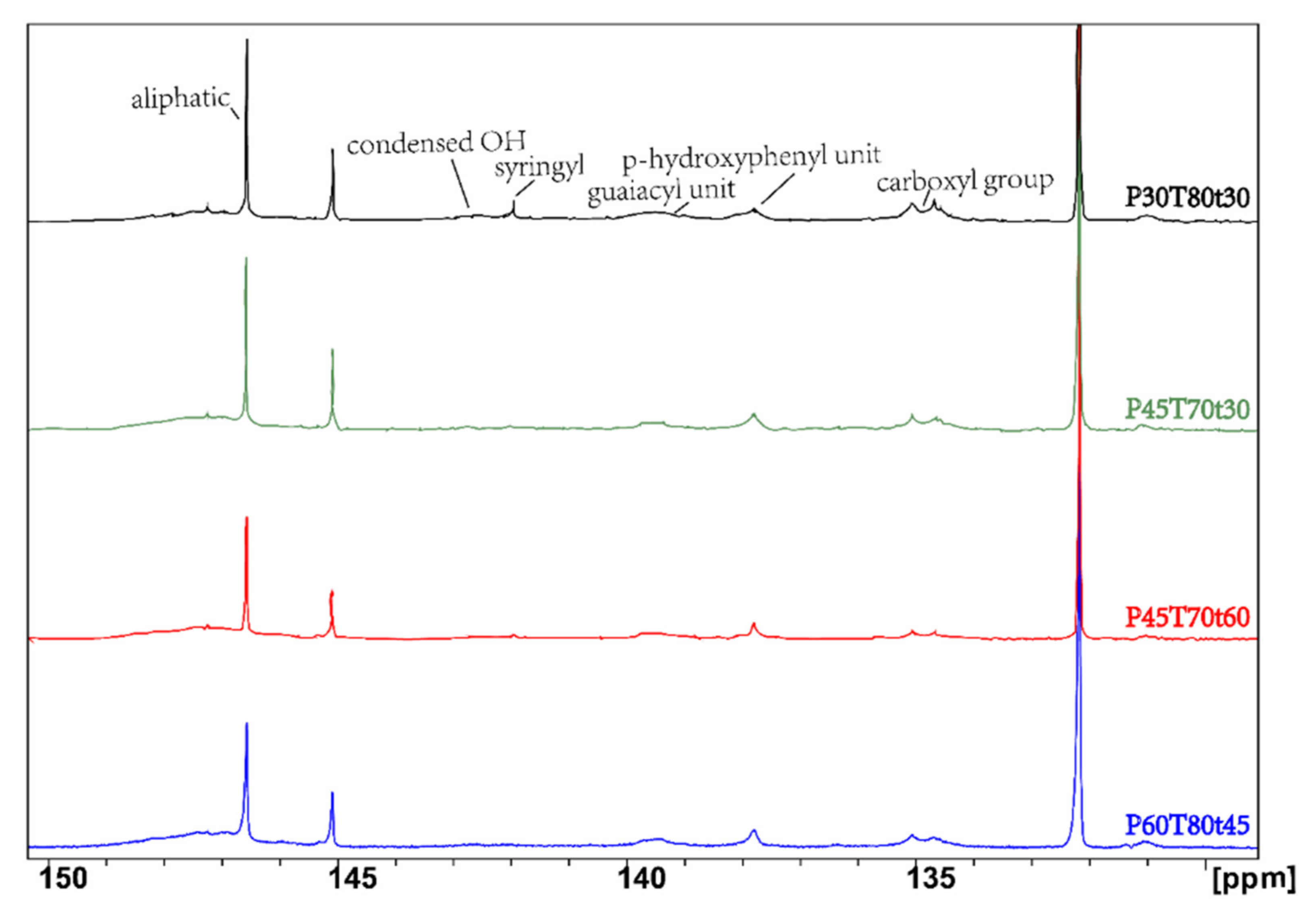
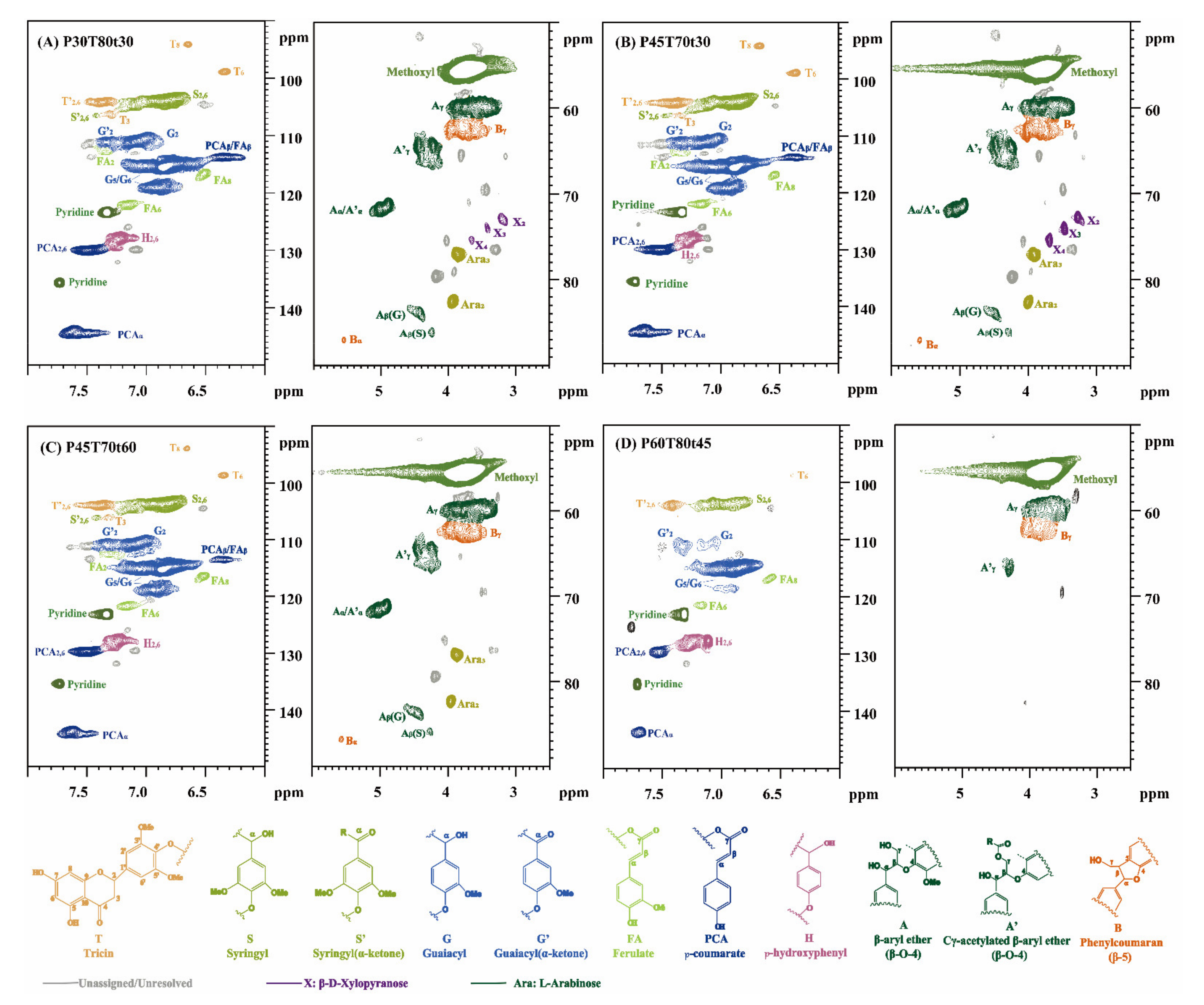
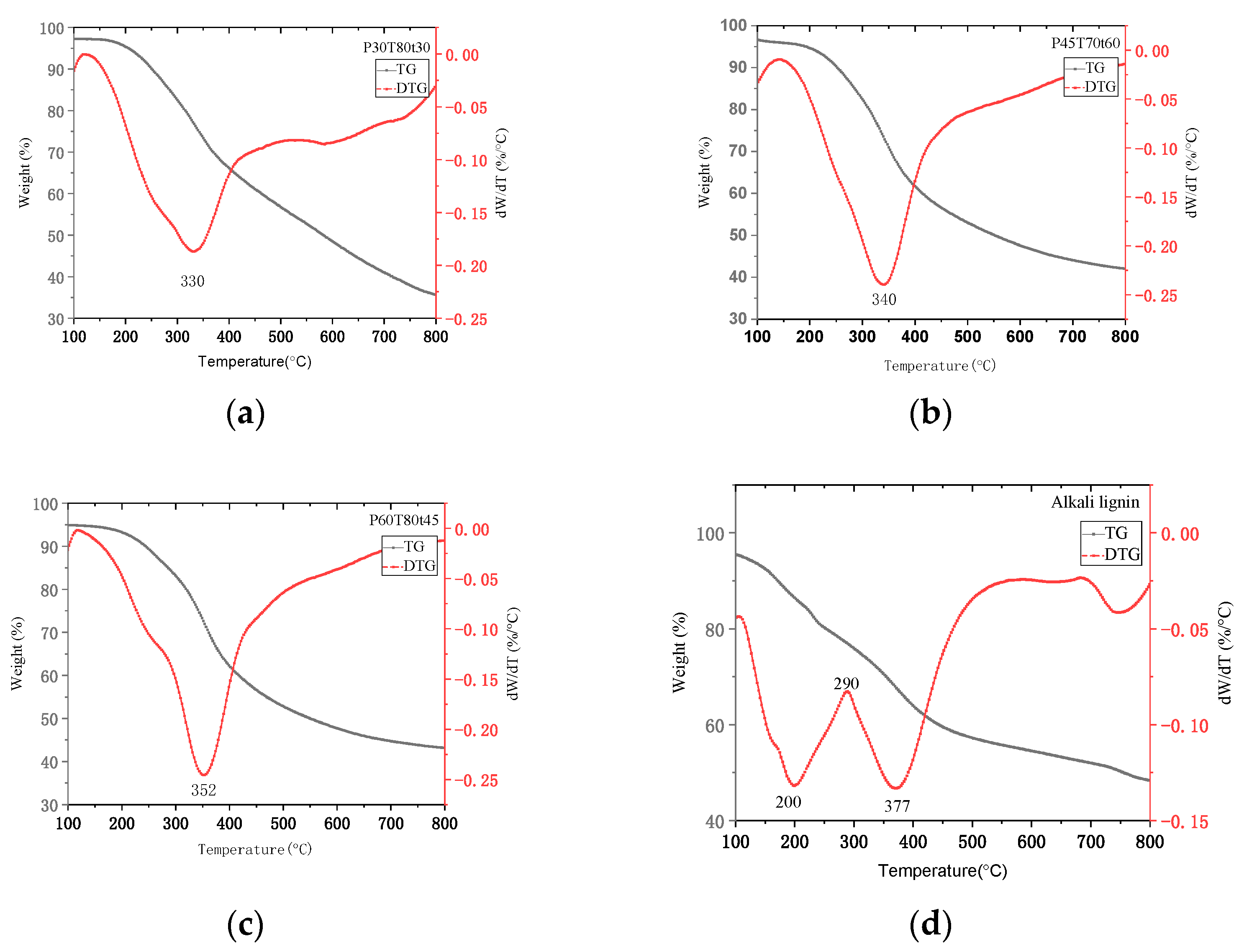
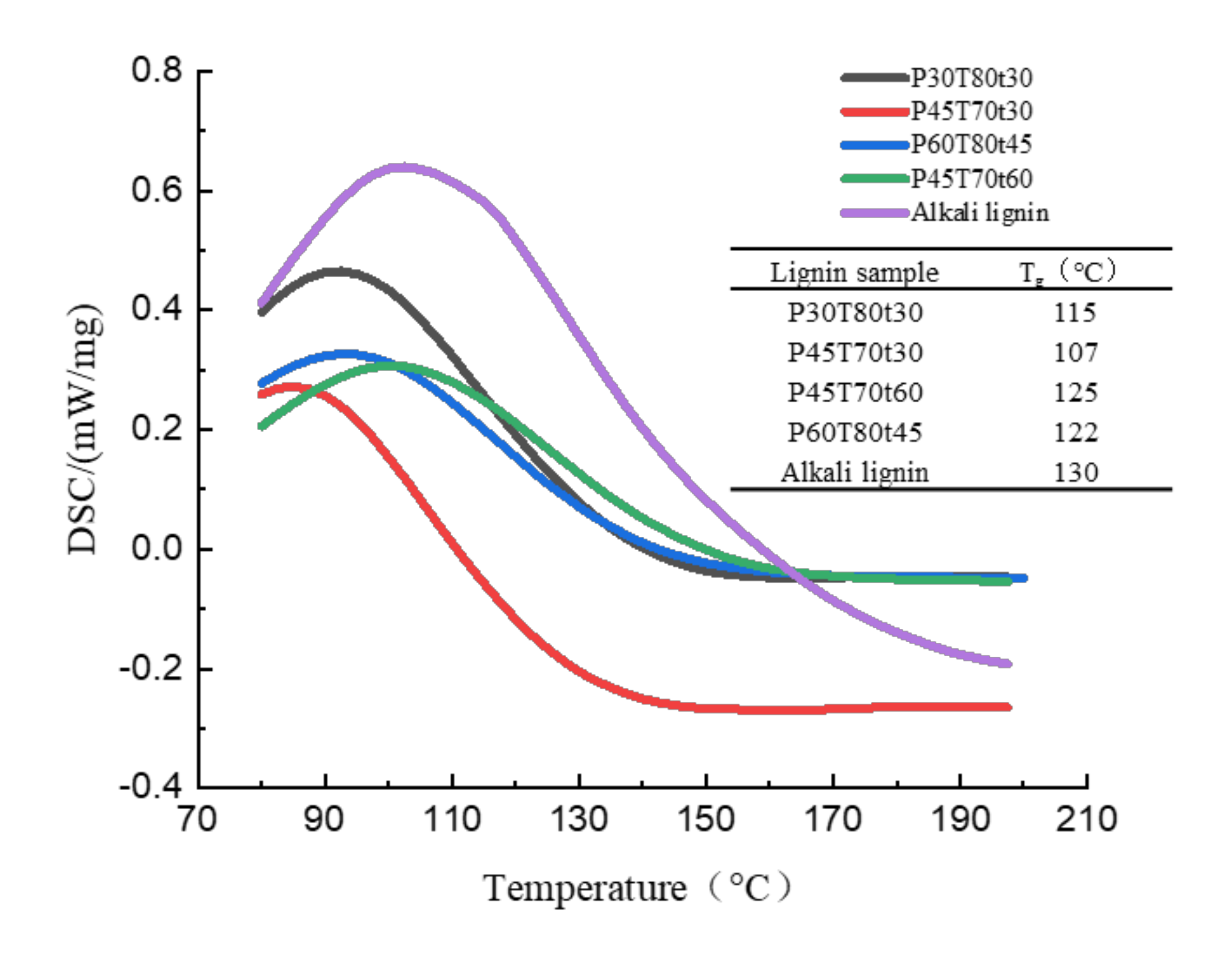
| Sample | Concentration (%) | Temperature (°C) | Time (min) | Lignin Removal Rate (%) | CDF (min·mol/L) |
|---|---|---|---|---|---|
| P20T70t60 | 20 | 70 | 60 | 18.3 | 1134.7 |
| P45T60t45 | 45 | 60 | 45 | 31.4 | 1593.5 |
| P30T70t45 | 30 | 70 | 45 | 32.8 | 1638.9 |
| P60T60t30 | 60 | 60 | 30 | 37.5 | 2172.9 |
| P30T80t30 | 30 | 80 | 30 | 39.9 | 2396.0 |
| P45T70t30 | 45 | 70 | 30 | 40.2 | 2442.1 |
| P60T70t15 | 60 | 70 | 15 | 43.0 | 2497.6 |
| P45T80t15 | 45 | 80 | 15 | 43.1 | 2677.7 |
| P45T70t60 | 45 | 70 | 60 | 46.5 | 4884.3 |
| P45T80t60 | 45 | 80 | 60 | 50.4 | 10,710.8 |
| P60T80t45 | 60 | 80 | 45 | 52.4 | 16,430.9 |
| Sample | Mw/Da | Mn/Da | PDI |
|---|---|---|---|
| P30T80t30 | 16055 | 2876 | 5.58 |
| P30T70t45 | 13394 | 2671 | 5.01 |
| P45T80t15 | 10537 | 2576 | 4.09 |
| P45T70t30 | 11074 | 2587 | 4.28 |
| P45T60t45 | 14276 | 2882 | 4.95 |
| P60T70t15 | 11458 | 2550 | 4.49 |
| P60T60t30 | 10111 | 2593 | 3.90 |
| P60T80t45 | 12061 | 2413 | 5.00 |
| Alkaline lignin | 4397 | 1428 | 3.08 |
| Sample | CDF (min·mol/L) | Aliphatic OH | Phenolic OH (mmol/g) | COOH | |||
|---|---|---|---|---|---|---|---|
| Syringyl (S) | Guaiacyl (G) | p-Hydroxyl (H) | Condensed | ||||
| P30T80t30 | 2396.0 | 2.51 | 0.13 | 0.44 | 0.40 | 0.31 | 0.69 |
| P45T70t30 | 2442.1 | 2.67 | 0.14 | 0.47 | 0.44 | 0.32 | 0.52 |
| P45T70t60 | 4884.3 | 2.16 | 0.13 | 0.42 | 0.35 | 0.29 | 0.69 |
| P60T80t45 | 16,430.9 | 1.73 | 0.21 | 0.50 | 0.40 | 0.50 | 0.88 |
| Sample | S | S′ | G | G′ | H | FA | pCA | A | B | S/G |
|---|---|---|---|---|---|---|---|---|---|---|
| P30T80t30 | 26.93 | 3.63 | 44.29 | 13.73 | 11.43 | 3.50 | 16.92 | 31.44 | 1.51 | 0.53 |
| P45T70t30 | 30.56 | 1.59 | 36.09 | 19.06 | 12.70 | 2.98 | 19.83 | 33.97. | 2.21 | 0.58 |
| P45T70t60 | 32.96 | 0.83 | 34.97 | 18.67 | 12.58 | 2.58 | 14.65 | 29.81 | 2.17 | 0.63 |
| P60T80t45 | 32.53 | 0.00 | 26.28 | 8.24 | 32.95 | 0.64 | 10.94 | 15.34 | 0.00 | 0.94 |
| Milled wood lignin [40] | 26 | NA | 65 | NA | 9 | 4 | 32 | 56 | 2 | 0.4 |
| Alkali oxygen lignin [40] | 23 | NA | 50 | NA | 27 | 4 | 1 | 7 | 1 | 0.5 |
| Sample | I(C9) | IFAα+ IpCAα | IT3 | IT’2,6 | IFA2 | IpCA2,6 | VC/100Ar |
|---|---|---|---|---|---|---|---|
| P30T80t30 | 0.113 | 0.0308 | 0.0165 | 0.0046 | 0.004 | 0.0382 | 68.4 |
| P45T70t30 | 0.104 | 0.0277 | 0.0031 | 0.0162 | 0.0031 | 0.0412 | 45.4 |
| P45T70t60 | 0.097 | 0.0201 | 0.0012 | 0.0158 | 0.0025 | 0.0284 | 35 |
| P60T80t45 | 0.07 | 0.0091 | 0 | 0.0154 | 0.0009 | 0.0154 | 21.1 |
Publisher’s Note: MDPI stays neutral with regard to jurisdictional claims in published maps and institutional affiliations. |
© 2021 by the authors. Licensee MDPI, Basel, Switzerland. This article is an open access article distributed under the terms and conditions of the Creative Commons Attribution (CC BY) license (https://creativecommons.org/licenses/by/4.0/).
Share and Cite
Yin, C.; Wang, M.; Ma, Q.; Bian, H.; Ren, H.; Dai, H.; Cheng, J. Valorization of Rice Straw via Hydrotropic Lignin Extraction and Its Characterization. Molecules 2021, 26, 4123. https://doi.org/10.3390/molecules26144123
Yin C, Wang M, Ma Q, Bian H, Ren H, Dai H, Cheng J. Valorization of Rice Straw via Hydrotropic Lignin Extraction and Its Characterization. Molecules. 2021; 26(14):4123. https://doi.org/10.3390/molecules26144123
Chicago/Turabian StyleYin, Chongxin, Min Wang, Qingzhi Ma, Huiyang Bian, Hao Ren, Hongqi Dai, and Jinlan Cheng. 2021. "Valorization of Rice Straw via Hydrotropic Lignin Extraction and Its Characterization" Molecules 26, no. 14: 4123. https://doi.org/10.3390/molecules26144123
APA StyleYin, C., Wang, M., Ma, Q., Bian, H., Ren, H., Dai, H., & Cheng, J. (2021). Valorization of Rice Straw via Hydrotropic Lignin Extraction and Its Characterization. Molecules, 26(14), 4123. https://doi.org/10.3390/molecules26144123







